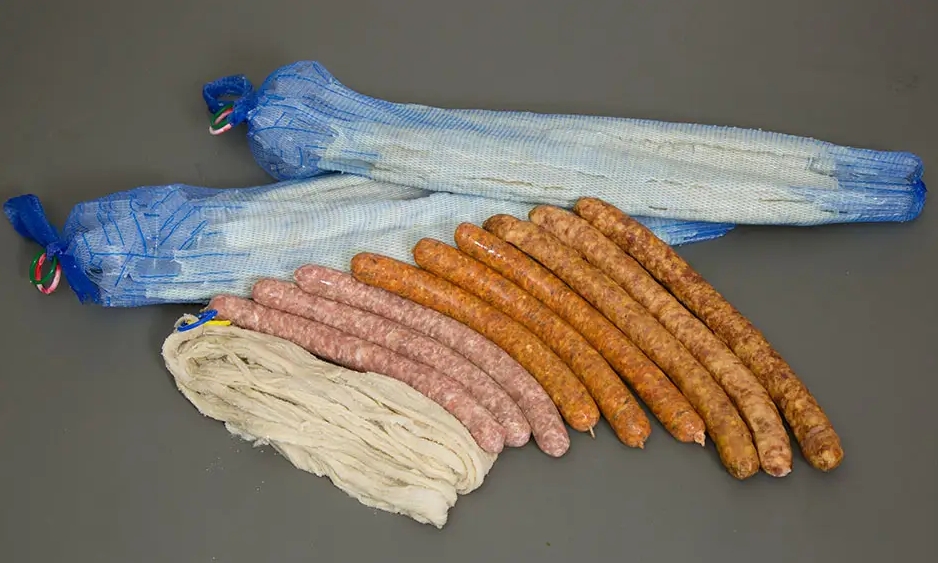Production Methods for Salted and Dried Casings

Winter is the season for collecting and processing pork casings. Processors should select raw pork intestines that are fresh in color, have a normal odor, are intact at both ends (with both the large and small ends present), free from breaks or wounds, measure over 14 meters in length per intestine, and are uncontaminated by mud or sand. Only such intestines can produce high-quality sausages. The production methods for two types of casings are described below:
1. Production Method for Salted Casings
Soaking & Rinsing: After removing fecal matter, immerse the small intestines in water. Flush the lumens with clean water at approximately 20°C and soak in fresh water for 24 hours.
Scraping: After soaking, remove the intestines and use a bamboo scraper to remove excess tissue from both the internal and external surfaces. Scrape off the inner mucosal layer to obtain a transparent membrane, taking care to avoid puncturing it.
Flushing: Insert a running water faucet into one end of the intestine and flush thoroughly. If any perforations or ulcers are found, excise those sections and rinse again.
Gauging & Bundling: After flushing, bundle the casings into hanks of 100 yards (approximately 91.5 meters) each, with a length tolerance not exceeding 1 meter. Each hank should contain no more than 16 segments, with each segment being no shorter than 2 meters.
Salting & Hanking: For the bundled casings, first separate all the knots. Sprinkle an appropriate amount of salt evenly over them, then place the casings on sieves. Stack the sieves on racks to drain the water. Cover the top and sides of the sieves with white cloth. During hanking, strive for consistent color within each hank; remove any discolored sections and untie any knots. After salting for 12-13 hours, when the interior of the casing reaches a semi-dry state, they can be hanked. This yields the semi-finished product known as "light casings".
Rinsing & Washing: Immerse the "light casings" in fresh water, changing the water repeatedly and washing thoroughly to ensure all impurities, both inside and outside, are removed. The water temperature for rinsing should not be too high.
Sorting & Final Salting: Fill the "light casings" with water to check for leaks. Then, sort and tie them into small hanks according to their diameter (caliber) and length. Subsequently, salt them with refined salt. After the moisture drains adequately, hank them again. This results in the finished product, known as "clean casings".
2. Production Method for Dried Casings
Soaking: Immerse the thoroughly cleaned small intestines in fresh water for several hours (extending to 1-2 days in winter).
Fat Removal: Place the soaked fresh intestines on a wooden board and remove the external fat, serous membrane, and fascia. Then, group the fresh intestines into sets of 10 tubes each. Place them in a vat, adding 2500 ml of a 5% sodium hydroxide solution for every 7-8 sets. Agitate the intestines rapidly to wash away the fat.
Rinsing: Transfer the degreased intestines to a vat of fresh water. Change the water repeatedly to rinse away blood, residual fat, and the smell of sodium hydroxide.
Salting: Use 0.75 - 1.0 kg of salt per 100 yards (approx. 91.5 meters) of casing. Salt the casings for 12-24 hours, then remove and rinse with water, striving to remove all salt residue as completely as possible.
Inflation: Use an air pump to inflate the cleaned casings, causing them to expand. Then, submerge them in clean water to check for leaks. Hang the inflated casings in a well-ventilated area to dry.
Flattening & Packing: Once dry, puncture one end of the casing with a needle to release the air. Spray water evenly to slightly moisten them, then flatten the casings. Bundle and tie them into hanks, after which they are ready to be packed into boxes.
